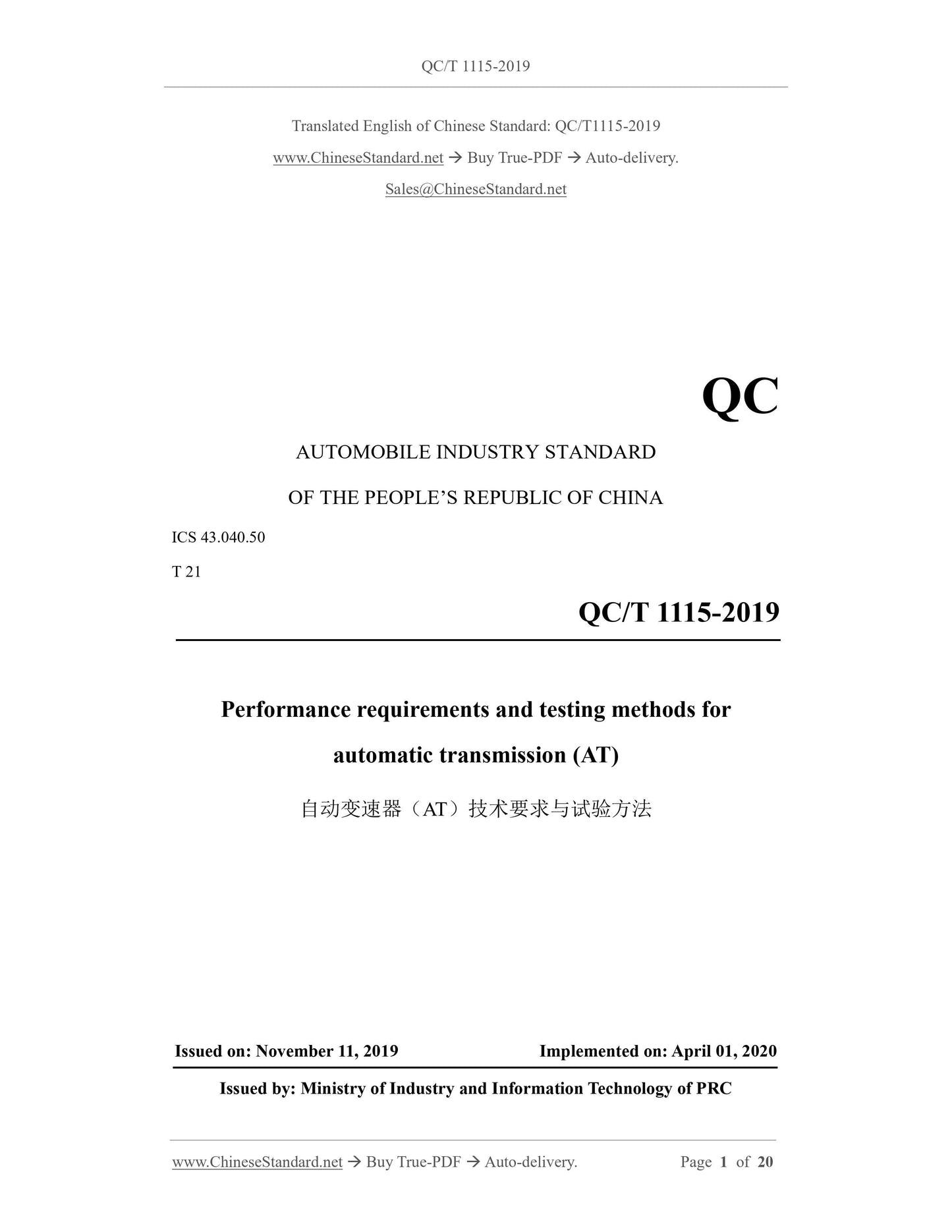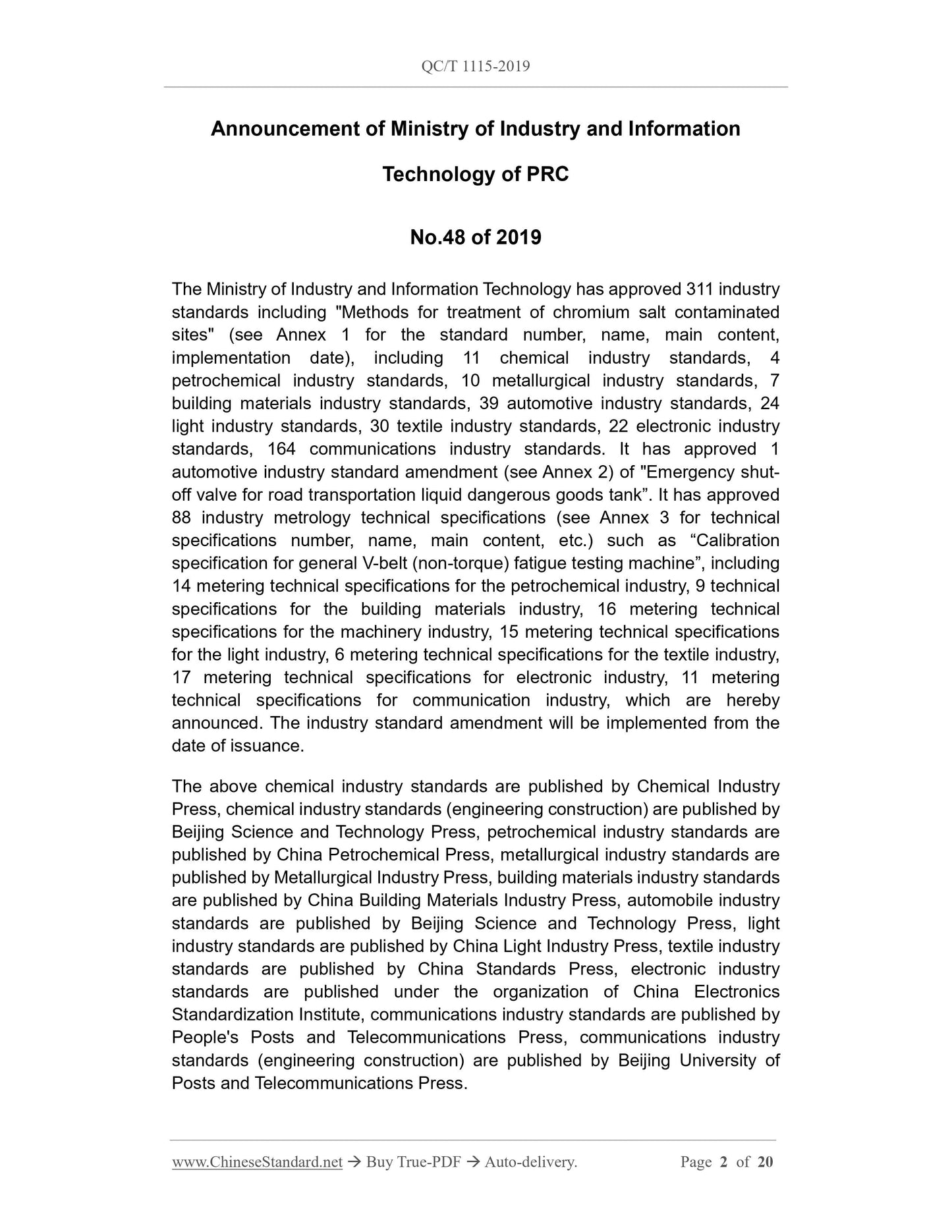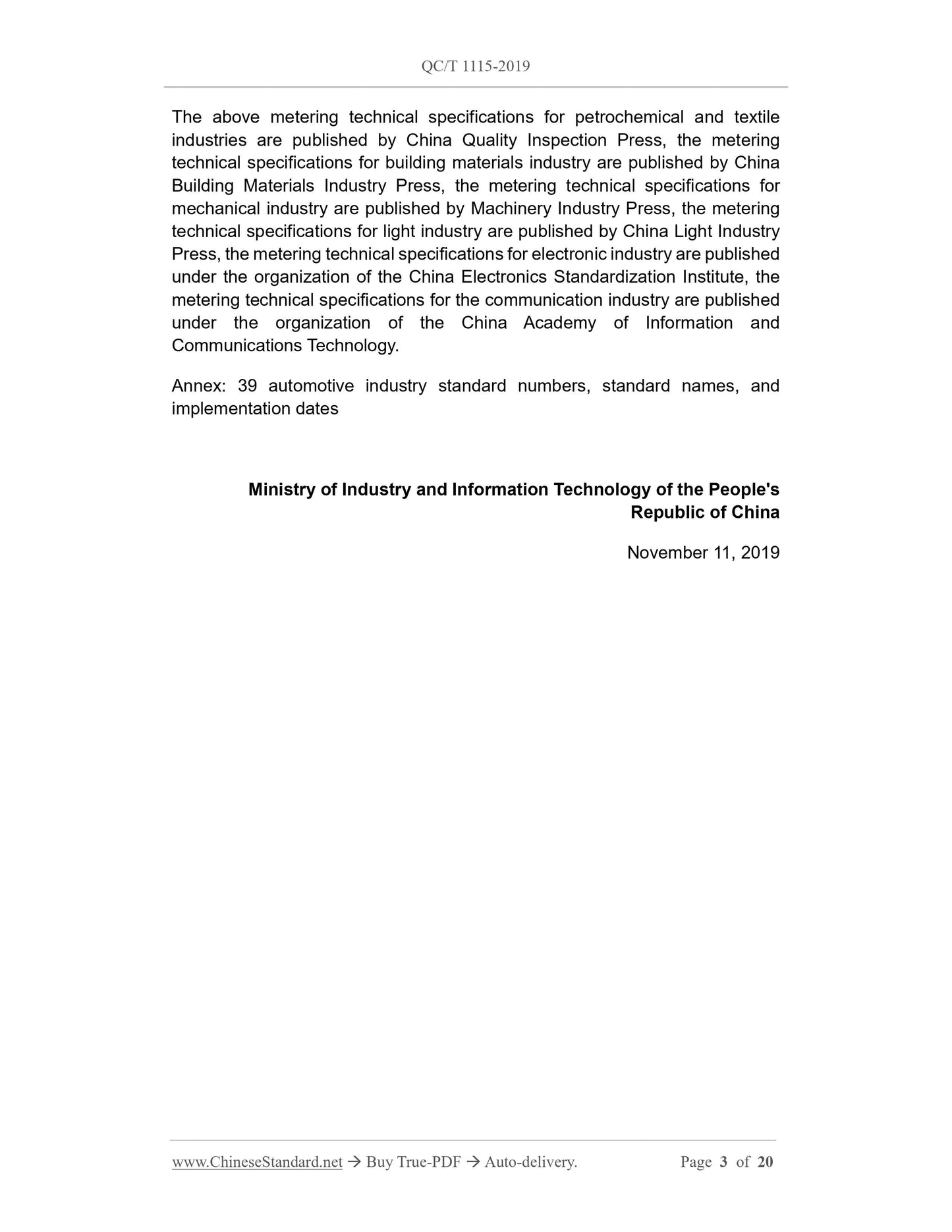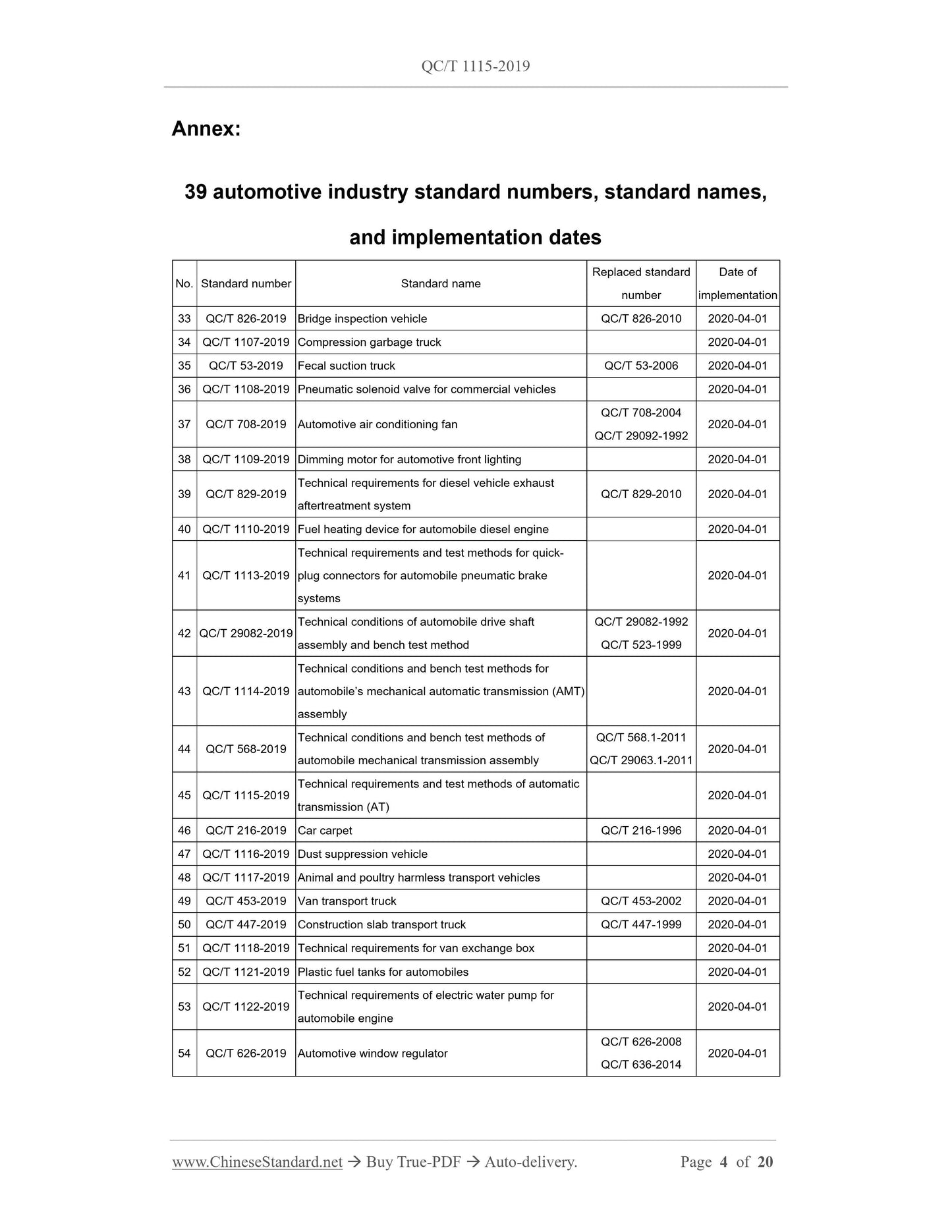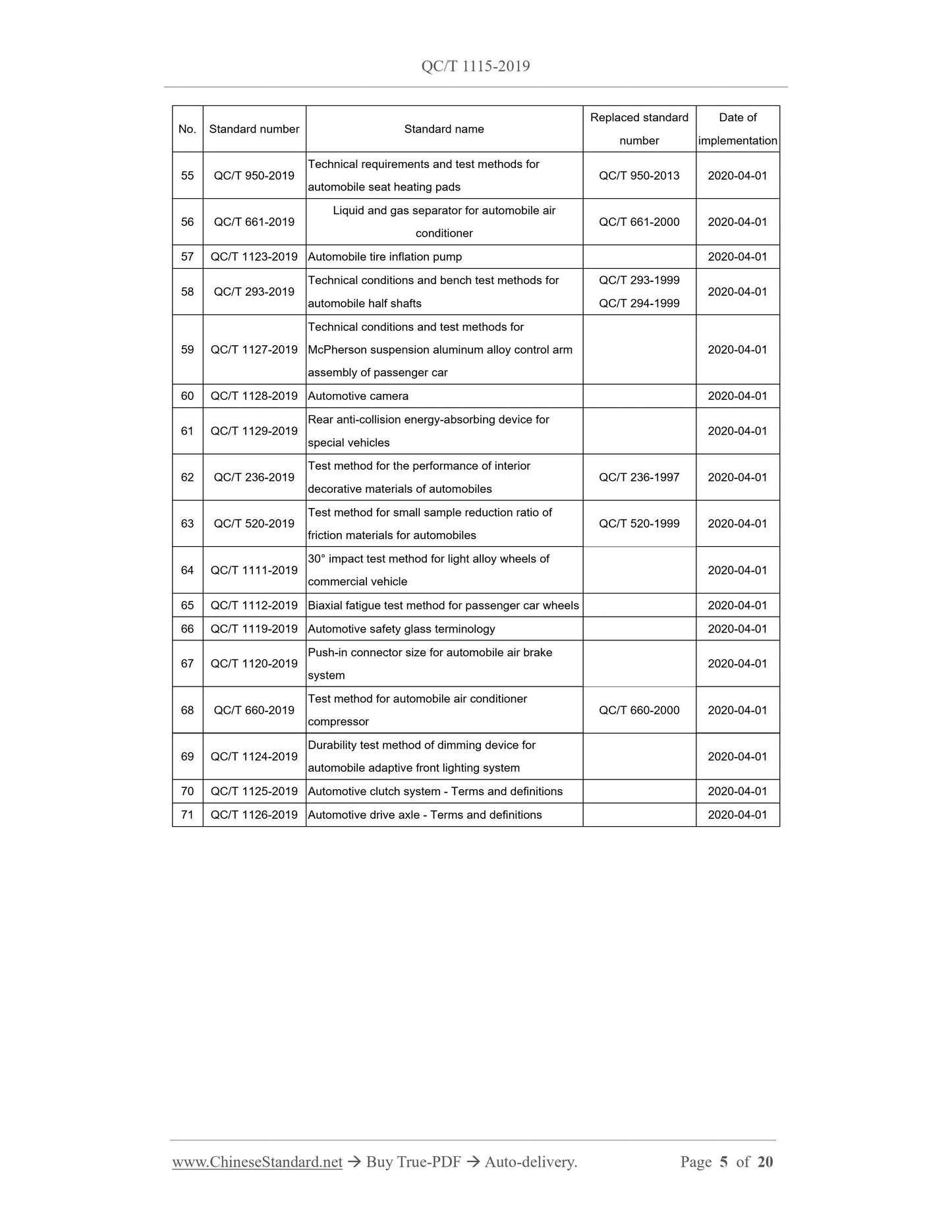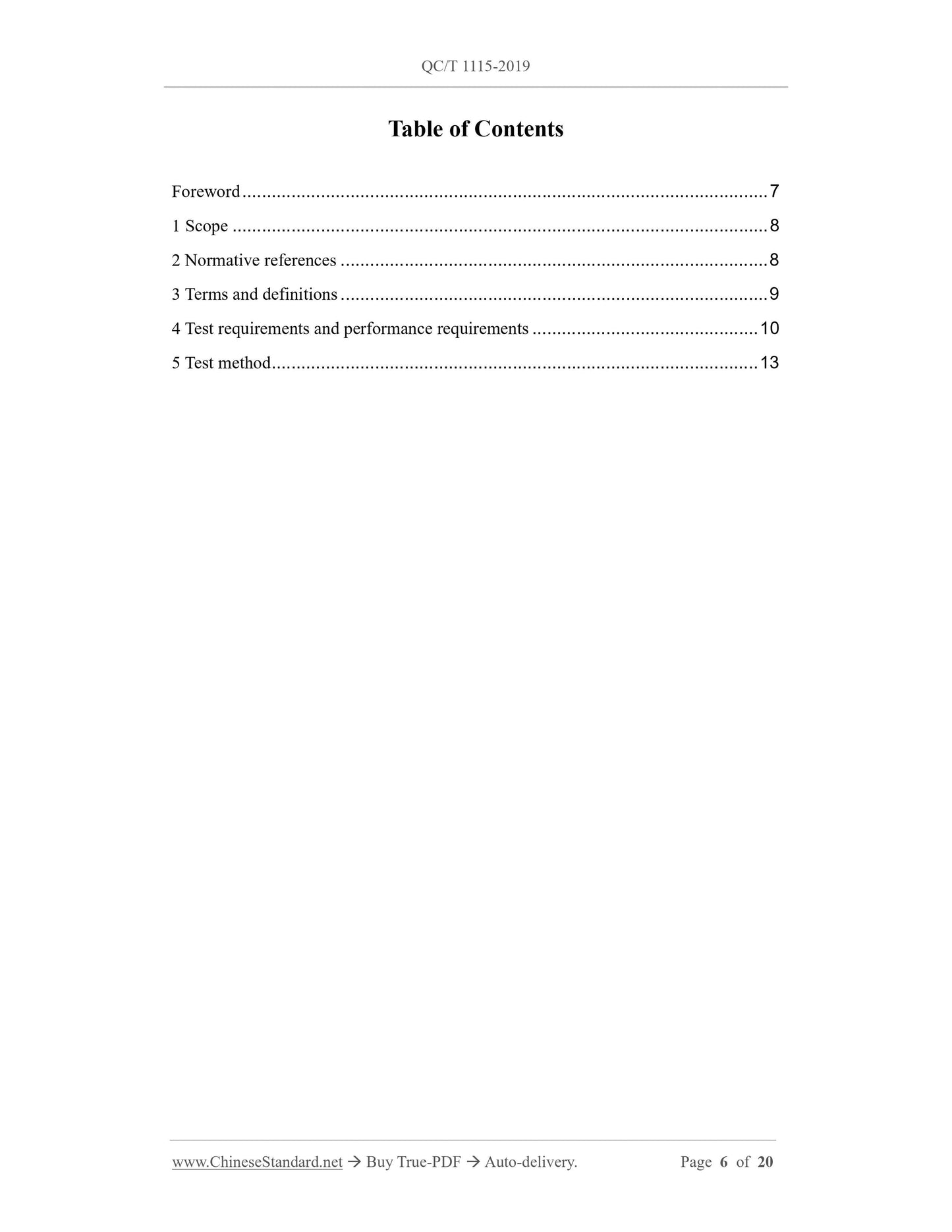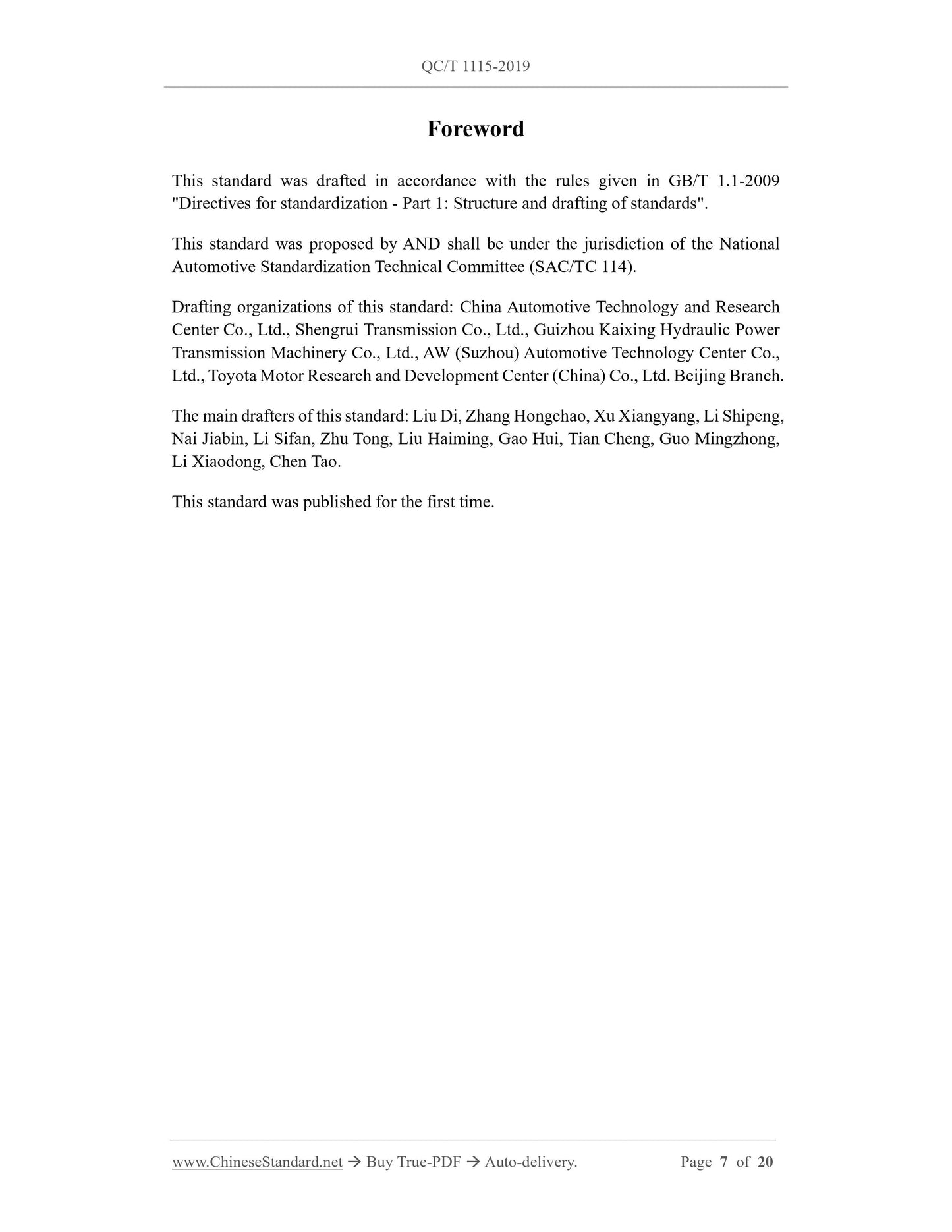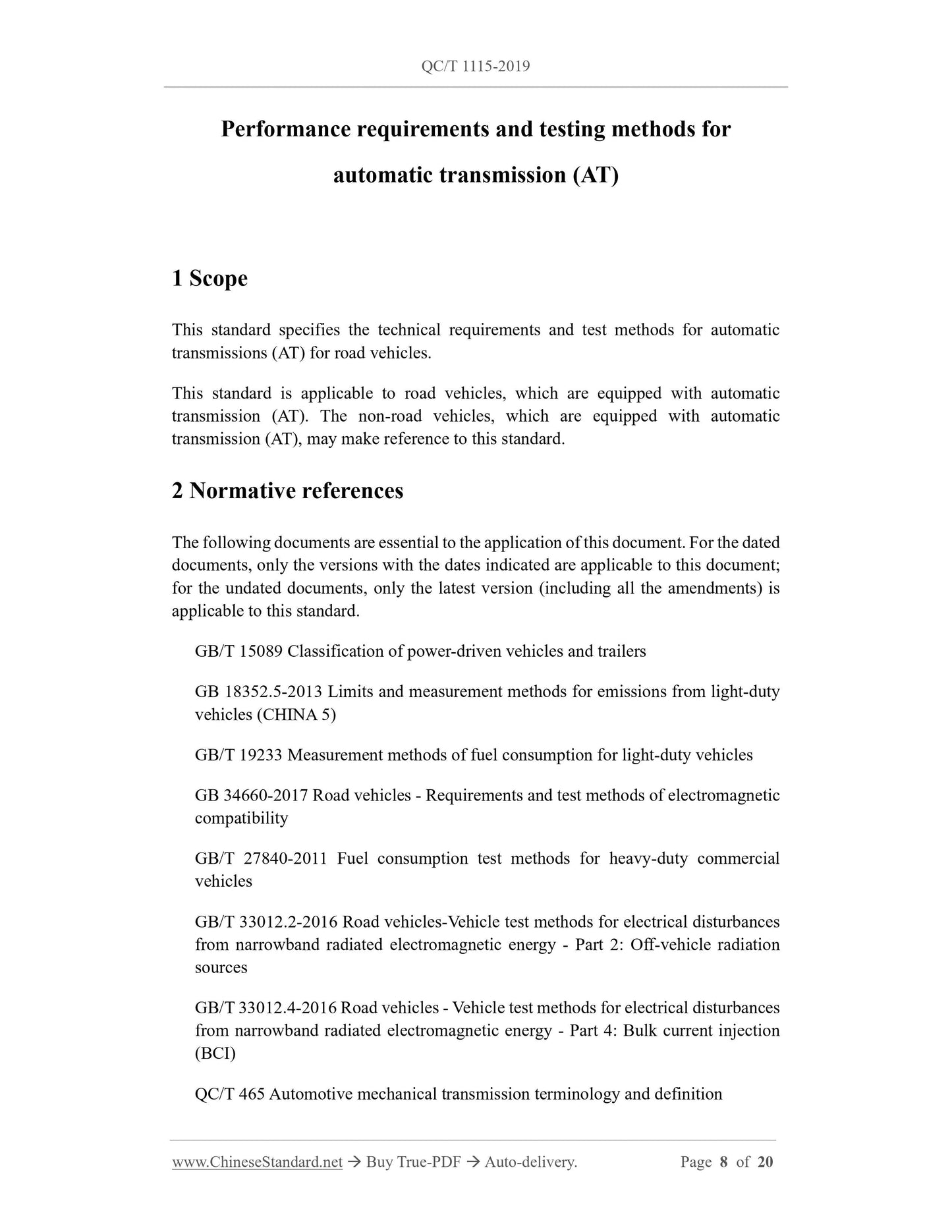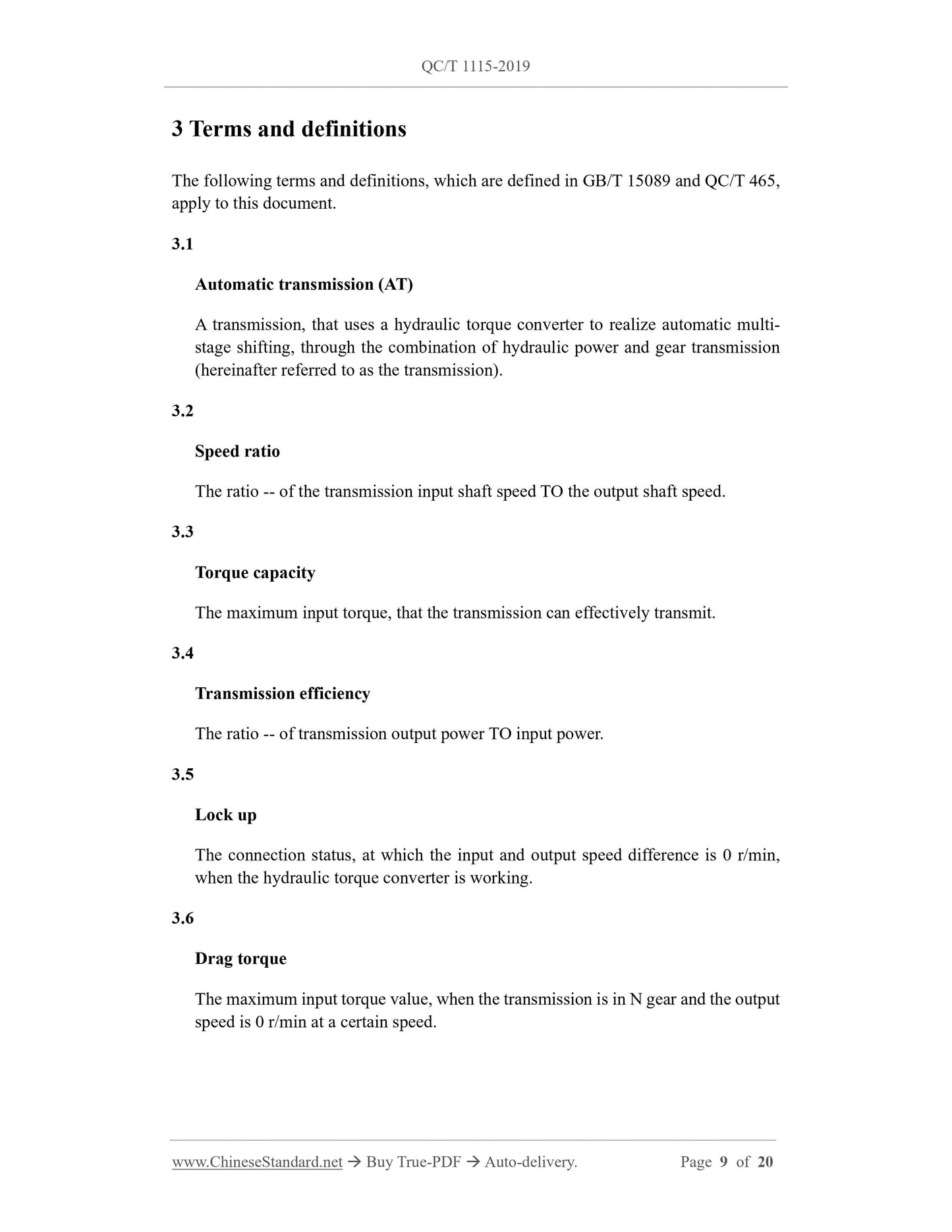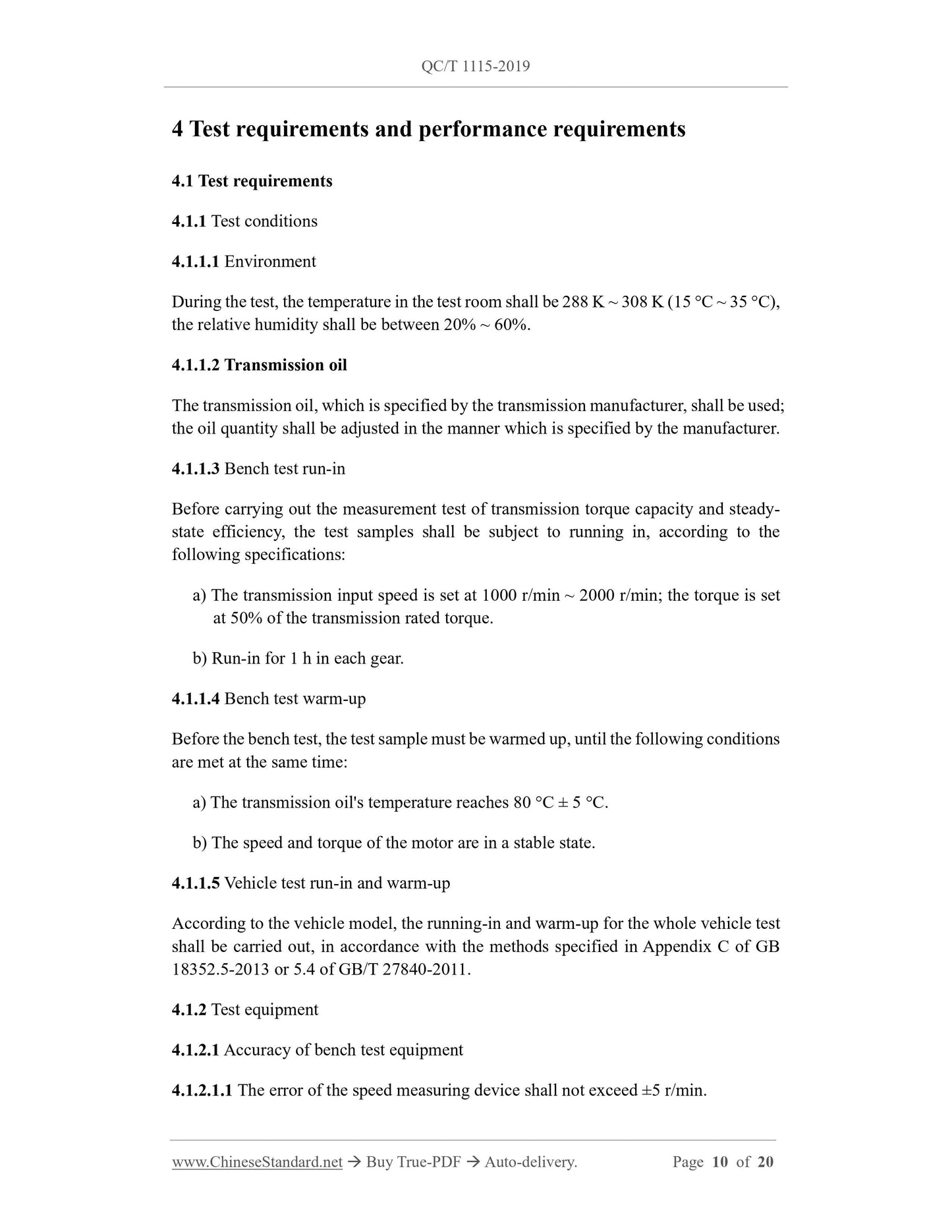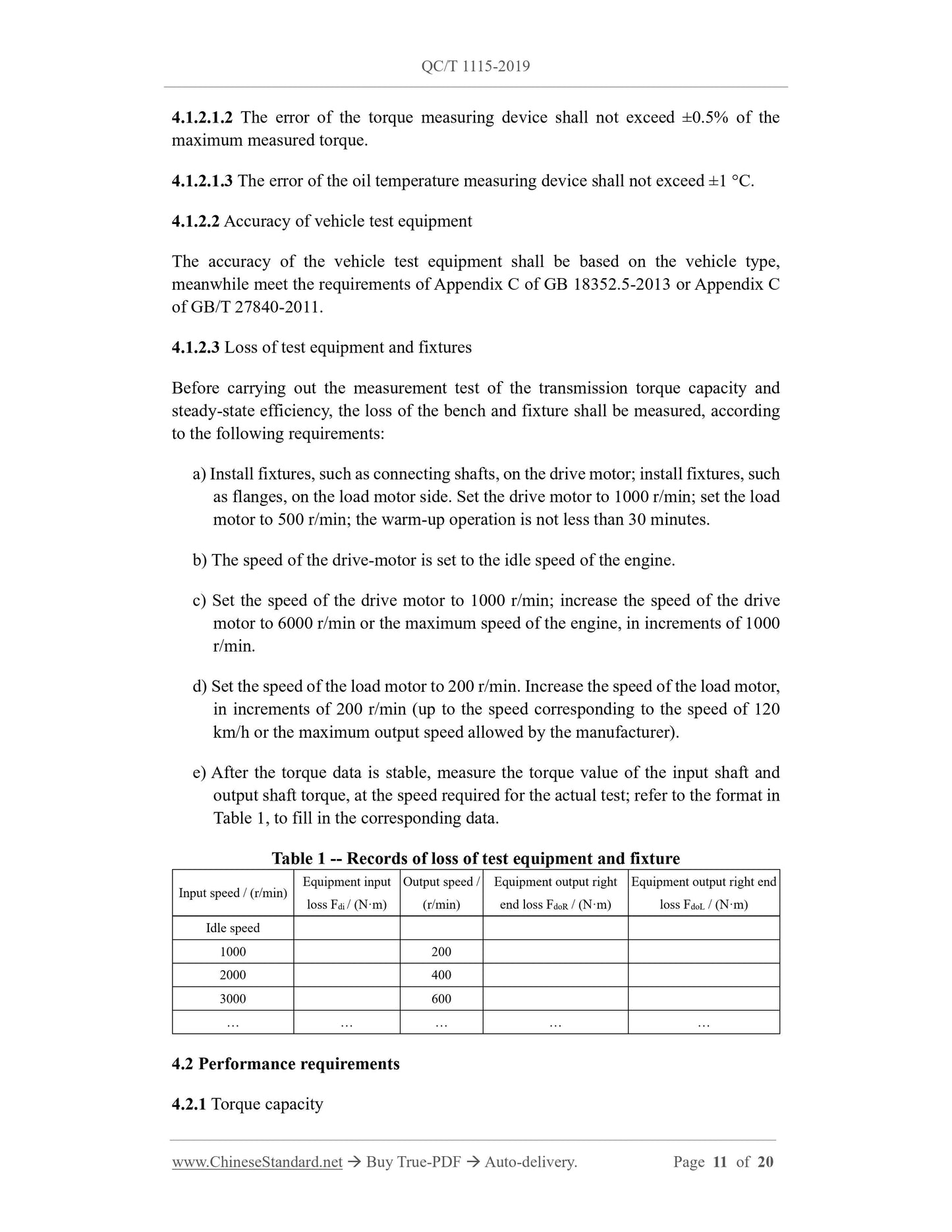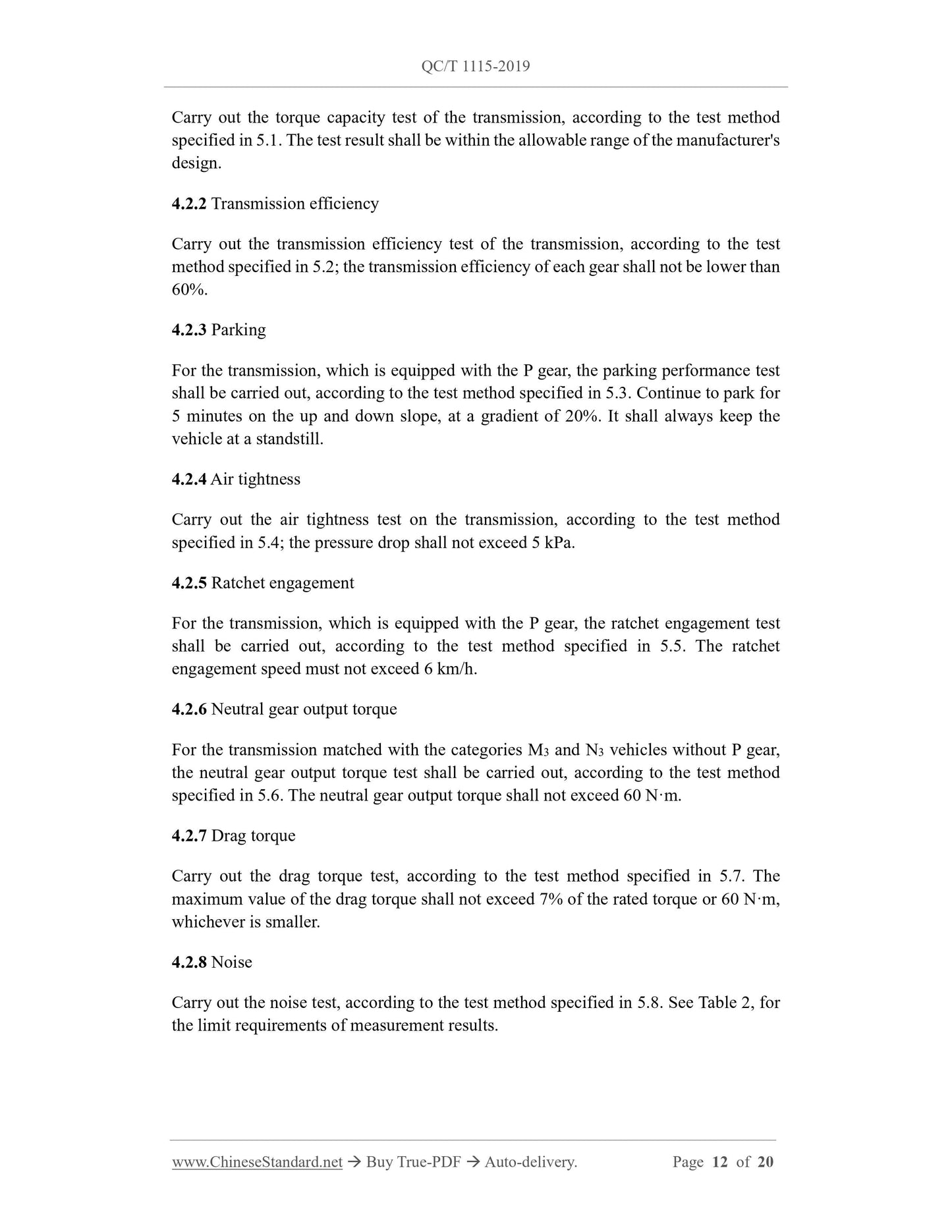1
/
of
12
PayPal, credit cards. Download editable-PDF & invoice in 1 second!
QC/T 1115-2019 English PDF (QCT1115-2019)
QC/T 1115-2019 English PDF (QCT1115-2019)
Regular price
$265.00 USD
Regular price
Sale price
$265.00 USD
Unit price
/
per
Shipping calculated at checkout.
Couldn't load pickup availability
Delivery: 3 seconds. Download true-PDF + Invoice.
Get QUOTATION in 1-minute: Click QC/T 1115-2019
Historical versions: QC/T 1115-2019
Preview True-PDF (Reload/Scroll if blank)
QC/T 1115-2019: Performance requirements and testing methods for automatic transmission(AT)
QC/T 1115-2019
QC
AUTOMOBILE INDUSTRY STANDARD
OF THE PEOPLE’S REPUBLIC OF CHINA
ICS 43.040.50
T 21
Performance requirements and testing methods for
automatic transmission (AT)
ISSUED ON: NOVEMBER 11, 2019
IMPLEMENTED ON: APRIL 01, 2020
Issued by: Ministry of Industry and Information Technology of PRC
Table of Contents
Foreword ... 7
1 Scope ... 8
2 Normative references ... 8
3 Terms and definitions ... 9
4 Test requirements and performance requirements ... 10
5 Test method ... 13
Performance requirements and testing methods for
automatic transmission (AT)
1 Scope
This standard specifies the technical requirements and test methods for automatic
transmissions (AT) for road vehicles.
This standard is applicable to road vehicles, which are equipped with automatic
transmission (AT). The non-road vehicles, which are equipped with automatic
transmission (AT), may make reference to this standard.
2 Normative references
The following documents are essential to the application of this document. For the dated
documents, only the versions with the dates indicated are applicable to this document;
for the undated documents, only the latest version (including all the amendments) is
applicable to this standard.
GB/T 15089 Classification of power-driven vehicles and trailers
GB 18352.5-2013 Limits and measurement methods for emissions from light-duty
vehicles (CHINA 5)
GB/T 19233 Measurement methods of fuel consumption for light-duty vehicles
GB 34660-2017 Road vehicles - Requirements and test methods of electromagnetic
compatibility
GB/T 27840-2011 Fuel consumption test methods for heavy-duty commercial
vehicles
GB/T 33012.2-2016 Road vehicles-Vehicle test methods for electrical disturbances
from narrowband radiated electromagnetic energy - Part 2: Off-vehicle radiation
sources
GB/T 33012.4-2016 Road vehicles - Vehicle test methods for electrical disturbances
from narrowband radiated electromagnetic energy - Part 4: Bulk current injection
(BCI)
QC/T 465 Automotive mechanical transmission terminology and definition
4 Test requirements and performance requirements
4.1 Test requirements
4.1.1 Test conditions
4.1.1.1 Environment
During the test, the temperature in the test room shall be 288 K ~ 308 K (15 °C ~ 35 °C),
the relative humidity shall be between 20% ~ 60%.
4.1.1.2 Transmission oil
The transmission oil, which is specified by the transmission manufacturer, shall be used;
the oil quantity shall be adjusted in the manner which is specified by the manufacturer.
4.1.1.3 Bench test run-in
Before carrying out the measurement test of transmission torque capacity and steady-
state efficiency, the test samples shall be subject to running in, according to the
following specifications:
a) The transmission input speed is set at 1000 r/min ~ 2000 r/min; the torque is set
at 50% of the transmission rated torque.
b) Run-in for 1 h in each gear.
4.1.1.4 Bench test warm-up
Before the bench test, the test sample must be warmed up, until the following conditions
are met at the same time:
a) The transmission oil's temperature reaches 80 °C ± 5 °C.
b) The speed and torque of the motor are in a stable state.
4.1.1.5 Vehicle test run-in and warm-up
According to the vehicle model, the running-in and warm-up for the whole vehicle test
shall be carried out, in accordance with the methods specified in Appendix C of GB
18352.5-2013 or 5.4 of GB/T 27840-2011.
4.1.2 Test equipment
4.1.2.1 Accuracy of bench test equipment
4.1.2.1.1 The error of the speed measuring device shall not exceed ±5 r/min.
Carry out the torque capacity test of the transmission, according to the test method
specified in 5.1. The test result shall be within the allowable range of the manufacturer's
design.
4.2.2 Transmission efficiency
Carry out the transmission efficiency test of the transmission, according to the test
method specified in 5.2; the transmission efficiency of each gear shall not be lower than
60%.
4.2.3 Parking
For the transmission, which is equipped with the P gear, the parking performance test
shall be carried out, according to the test method specified in 5.3. Continue to park for
5 minutes on the up and down slope, at a gradient of 20%. It shall always keep the
vehicle at a standstill.
4.2.4 Air tightness
Carry out the air tightness test on the transmission, according to the test method
specified in 5.4; the pressure drop shall not exceed 5 kPa.
4.2.5 Ratchet engagement
For the transmission, which is equipped with the P gear, the ratchet engagement test
shall be carried out, according to the test method specified in 5.5. The ratchet
engagement speed must not exceed 6 km/h.
4.2.6 Neutral gear output torque
For the transmission matched with the categories M3 and N3 vehicles without P gear,
the neutral gear output torque test shall be carried out, according to the test method
specified in 5.6. The neutral gear output torque shall not exceed 60 Nꞏm.
4.2.7 Drag torque
Carry out the drag torque test, according to the test method specified in 5.7. The
maximum value of the drag torque shall not exceed 7% of the rated torque or 60 Nꞏm,
whichever is smaller.
4.2.8 Noise
Carry out the noise test, according to the test method specified in 5.8. See Table 2, for
the limit requirements of measurement results.
5.1.1.1.4 The joints shall be effectively sealed, without oil leakage.
5.1.1.2 Run-in
The transmission assembly under test shall be run-in, according to the requirements of
4.1.1.3.
5.1.2 Test procedure
5.1.2.1 The load motor is set to speed control mode.
5.1.2.2 The drive motor is set to torque control mode.
5.1.2.3 The transmission is in the D gear.
5.1.2.4 The hydraulic torque converter is locked up.
5.1.2.5 Increase the input speed of the transmission to the test speed, which is specified
by the manufacturer.
5.1.2.6 Adjust the controller; test in each gear, respectively.
5.1.2.7 Gradually increase the input torque to the rated value, which is specified by the
manufacturer; keep the torque stable for not less than 30 s.
5.1.3 Test result processing
During the test, the difference -- between the theoretical speed and the actual speed of
the transmission load motor -- shall not exceed 5%; the input torque at this time is the
torque capacity, which shall be corrected according to formula (1):
Where:
Tc - Torque capacity;
Ti - Input torque;
Fdi - Loss of torque at the equipment input.
5.2 Transmission efficiency
5.2.1 Test preparation
The preparation before the test shall be carried out, according to the provisions of 5.1.1.
5.2.2 Test procedure
Fdi - Lost torque of the input device, Nꞏm.
5.3 Parking
5.3.1 Test preparation
Preparations before the test shall be carried out, in accordance with the provisions of
4.1.1.5.
The vehicle shall be fully loaded; the tires of the specified size shall be used; the tire
pressure shall reach the specified value.
5.3.2 Test procedure
Drive the test vehicle to the middle of the 20% slope. Keep the longitudinal centerline
of the vehicle parallel to the centerline of the slope. Step on the service brake pedal, to
make the vehicle completely stationary. Shift the transmission from D to P. Then release
it service brake pedal, to confirm the performance of parking on a slope. Change the
parking direction of the vehicle on a slope, to confirm the performance of parking on a
slo...
Get QUOTATION in 1-minute: Click QC/T 1115-2019
Historical versions: QC/T 1115-2019
Preview True-PDF (Reload/Scroll if blank)
QC/T 1115-2019: Performance requirements and testing methods for automatic transmission(AT)
QC/T 1115-2019
QC
AUTOMOBILE INDUSTRY STANDARD
OF THE PEOPLE’S REPUBLIC OF CHINA
ICS 43.040.50
T 21
Performance requirements and testing methods for
automatic transmission (AT)
ISSUED ON: NOVEMBER 11, 2019
IMPLEMENTED ON: APRIL 01, 2020
Issued by: Ministry of Industry and Information Technology of PRC
Table of Contents
Foreword ... 7
1 Scope ... 8
2 Normative references ... 8
3 Terms and definitions ... 9
4 Test requirements and performance requirements ... 10
5 Test method ... 13
Performance requirements and testing methods for
automatic transmission (AT)
1 Scope
This standard specifies the technical requirements and test methods for automatic
transmissions (AT) for road vehicles.
This standard is applicable to road vehicles, which are equipped with automatic
transmission (AT). The non-road vehicles, which are equipped with automatic
transmission (AT), may make reference to this standard.
2 Normative references
The following documents are essential to the application of this document. For the dated
documents, only the versions with the dates indicated are applicable to this document;
for the undated documents, only the latest version (including all the amendments) is
applicable to this standard.
GB/T 15089 Classification of power-driven vehicles and trailers
GB 18352.5-2013 Limits and measurement methods for emissions from light-duty
vehicles (CHINA 5)
GB/T 19233 Measurement methods of fuel consumption for light-duty vehicles
GB 34660-2017 Road vehicles - Requirements and test methods of electromagnetic
compatibility
GB/T 27840-2011 Fuel consumption test methods for heavy-duty commercial
vehicles
GB/T 33012.2-2016 Road vehicles-Vehicle test methods for electrical disturbances
from narrowband radiated electromagnetic energy - Part 2: Off-vehicle radiation
sources
GB/T 33012.4-2016 Road vehicles - Vehicle test methods for electrical disturbances
from narrowband radiated electromagnetic energy - Part 4: Bulk current injection
(BCI)
QC/T 465 Automotive mechanical transmission terminology and definition
4 Test requirements and performance requirements
4.1 Test requirements
4.1.1 Test conditions
4.1.1.1 Environment
During the test, the temperature in the test room shall be 288 K ~ 308 K (15 °C ~ 35 °C),
the relative humidity shall be between 20% ~ 60%.
4.1.1.2 Transmission oil
The transmission oil, which is specified by the transmission manufacturer, shall be used;
the oil quantity shall be adjusted in the manner which is specified by the manufacturer.
4.1.1.3 Bench test run-in
Before carrying out the measurement test of transmission torque capacity and steady-
state efficiency, the test samples shall be subject to running in, according to the
following specifications:
a) The transmission input speed is set at 1000 r/min ~ 2000 r/min; the torque is set
at 50% of the transmission rated torque.
b) Run-in for 1 h in each gear.
4.1.1.4 Bench test warm-up
Before the bench test, the test sample must be warmed up, until the following conditions
are met at the same time:
a) The transmission oil's temperature reaches 80 °C ± 5 °C.
b) The speed and torque of the motor are in a stable state.
4.1.1.5 Vehicle test run-in and warm-up
According to the vehicle model, the running-in and warm-up for the whole vehicle test
shall be carried out, in accordance with the methods specified in Appendix C of GB
18352.5-2013 or 5.4 of GB/T 27840-2011.
4.1.2 Test equipment
4.1.2.1 Accuracy of bench test equipment
4.1.2.1.1 The error of the speed measuring device shall not exceed ±5 r/min.
Carry out the torque capacity test of the transmission, according to the test method
specified in 5.1. The test result shall be within the allowable range of the manufacturer's
design.
4.2.2 Transmission efficiency
Carry out the transmission efficiency test of the transmission, according to the test
method specified in 5.2; the transmission efficiency of each gear shall not be lower than
60%.
4.2.3 Parking
For the transmission, which is equipped with the P gear, the parking performance test
shall be carried out, according to the test method specified in 5.3. Continue to park for
5 minutes on the up and down slope, at a gradient of 20%. It shall always keep the
vehicle at a standstill.
4.2.4 Air tightness
Carry out the air tightness test on the transmission, according to the test method
specified in 5.4; the pressure drop shall not exceed 5 kPa.
4.2.5 Ratchet engagement
For the transmission, which is equipped with the P gear, the ratchet engagement test
shall be carried out, according to the test method specified in 5.5. The ratchet
engagement speed must not exceed 6 km/h.
4.2.6 Neutral gear output torque
For the transmission matched with the categories M3 and N3 vehicles without P gear,
the neutral gear output torque test shall be carried out, according to the test method
specified in 5.6. The neutral gear output torque shall not exceed 60 Nꞏm.
4.2.7 Drag torque
Carry out the drag torque test, according to the test method specified in 5.7. The
maximum value of the drag torque shall not exceed 7% of the rated torque or 60 Nꞏm,
whichever is smaller.
4.2.8 Noise
Carry out the noise test, according to the test method specified in 5.8. See Table 2, for
the limit requirements of measurement results.
5.1.1.1.4 The joints shall be effectively sealed, without oil leakage.
5.1.1.2 Run-in
The transmission assembly under test shall be run-in, according to the requirements of
4.1.1.3.
5.1.2 Test procedure
5.1.2.1 The load motor is set to speed control mode.
5.1.2.2 The drive motor is set to torque control mode.
5.1.2.3 The transmission is in the D gear.
5.1.2.4 The hydraulic torque converter is locked up.
5.1.2.5 Increase the input speed of the transmission to the test speed, which is specified
by the manufacturer.
5.1.2.6 Adjust the controller; test in each gear, respectively.
5.1.2.7 Gradually increase the input torque to the rated value, which is specified by the
manufacturer; keep the torque stable for not less than 30 s.
5.1.3 Test result processing
During the test, the difference -- between the theoretical speed and the actual speed of
the transmission load motor -- shall not exceed 5%; the input torque at this time is the
torque capacity, which shall be corrected according to formula (1):
Where:
Tc - Torque capacity;
Ti - Input torque;
Fdi - Loss of torque at the equipment input.
5.2 Transmission efficiency
5.2.1 Test preparation
The preparation before the test shall be carried out, according to the provisions of 5.1.1.
5.2.2 Test procedure
Fdi - Lost torque of the input device, Nꞏm.
5.3 Parking
5.3.1 Test preparation
Preparations before the test shall be carried out, in accordance with the provisions of
4.1.1.5.
The vehicle shall be fully loaded; the tires of the specified size shall be used; the tire
pressure shall reach the specified value.
5.3.2 Test procedure
Drive the test vehicle to the middle of the 20% slope. Keep the longitudinal centerline
of the vehicle parallel to the centerline of the slope. Step on the service brake pedal, to
make the vehicle completely stationary. Shift the transmission from D to P. Then release
it service brake pedal, to confirm the performance of parking on a slope. Change the
parking direction of the vehicle on a slope, to confirm the performance of parking on a
slo...
Share
